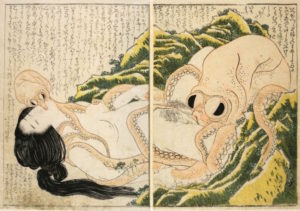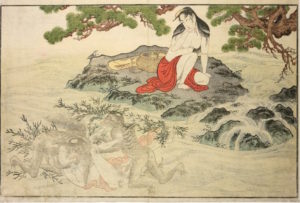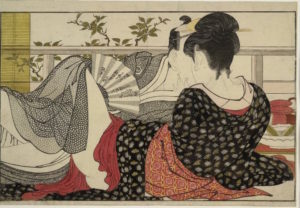By Elizabeth Emery, Guest Contributor
Recent news reports and opinion pieces lament the emotional stunting of male millennials addicted to violent Internet porn, and propose that things were different when graphic material was harder to obtain and share. Inspired by such thinking, the present installment of “Bric-a-brac-o-mania” flashes back to the 1860s when Japanese shunga, or pillow books, albums featuring couples in fantastically gymnastic or incongruent sexual positions (taking tea, admiring scenery, fetching water, copulating with sea creatures), were all the rage in Paris.
Edmond de Goncourt, one of the trendsetters of the movement known as japonisme expressed delight in 1863 at his acquisition of one such album “of Japanese obscenities,” noting the “violence of their lines, the unexpected nature of the couplings and arrangements of accessories, the whimsy of poses and things, in other words, the picturesque landscape of genitalia” (Journal, October 1863). The “picturesque landscape of genitalia” seems to have haunted him. He later recorded an erotic dream (14 November 1884) where photographer Paul Nadar invited him for a ménage à trois involving a reenactment of scenes from another such Japanese album given to him by Paul Bonnetain (the author of a scandalous 1883 book about masturbation), and he bragged about a visit from sculptor Auguste Rodin who, in a “faunlike” period, studied Goncourt’s “Japanese erotics.” Rodin is said to have reveled in these scenes of “women throwing their heads back, necks breaking, arms nervously extended, feet contracted, all of the voluptuous and frenetic reality of sex, sculptural intertwining of bodies melted and contained in the spasm of pleasure,” a description that suggests the sculptor’s erotic drawings may well have been inspired by shunga (Journal, 5 January 1887; all translations from the French are mine).
Goncourt would reprise much of the same vocabulary in his book-length studies of artists Utamaro (1891) and Hokusai (1896) where he similarly fixates on violence done to women. He is so troubled by Hokusai’s “Fisherman’s Wife” (also known as Kinoe no komatsu; Figure 1) that he recycles his “painterly” description of this “terrible” and “terrifying” print from one book to the other: “On seaweed-slimed rocks a naked woman’s body, a naked woman’s body [repeated twice in the original], lies passed out from pleasure, sicut cadaver, to the extent that it is impossible to tell whether she is drowned or alive, and whose lower body is being slurped by an immense octopus with frightening black half crescent pupils, while a small octopus hungrily eats her mouth” (Outamaro 136). Fans of the television series Mad Men will recognize this as the print that graced Burt Cooper’s office for several seasons before being gifted to Peggy Olsen as a mark of her success.
Goncourt accurately describes this image, yet his choice of words, with their insistence on nudity, necrophilia, monstrosity, and the ingestion of flesh– major Western taboos– enhances the print’s shock value. By grouping it with similarly graphic descriptions of two other “disturbing” images he further compounds the seeming violence of shunga. The first is a sea scene by Utamaro (the “Abalone Diver”), which he describes as the rape of a sea goddess (138-139).
Rape is once again the subject of his lengthy description of what he labels Utamaro’s personification of Lust, a ghastly “blood-drained” fleshy man “deformed by a spasm of pleasure” (138). Goncourt does not, however, mention the woman’s agency: she fights off her attacker, biting him and telling him to stop.
Goncourt’s obsessive focus on the violent ingestion or possession of women, dead or alive, and his emphasis on the “toadlike” nature of male pleasure, projects his own Western taboos about bodies and sexuality onto an art that modern scholars have shown to have been much more egalitarian in shunga’s own cultural context. Such images may have served an “auto-erotic” function for men and women alike (Screech 23-27), or may have been consulted as fashion guides, for sexual education, or as humorous riffs on mythological tales. The first image, for example, does not chronicle an act of necrophilia; instead it acknowledges the universality of sexual appetites. In the online dossier created by the British Museum in conjunction with its 2013-2014 exhibit, “Shunga: Sex and Pleasure in Japanese art, 1600-1900,” curators translate dialogue (the characters above the images) showing that the two octopi express their delight that the woman has finally visited them and speak competitively of their sexual prowess. Her initial insults break into graphic onomatopoetic representations of orgasm. Like the second image this one also evokes stories about sensuous women divers from Japanese mythology.
In fact, representations of sexual violence were uncommon in shunga, Goncourt’s obsessive focus on it notwithstanding (the bottom three figures are drawn from an Utamaro album containing twelve prints, but he describes only the most disturbing ones). Sexual violence and tenderness are merely two of several possible models represented across individual albums, many of which, as curators at the British Museum note, seek “to show as many different kinds of coupling as possible, which has the effect of emphasizing the universality of sex.” This includes scenes of solitary arousal as well as the involvement of a third gender, young men known as wakashū, who pleasured (and were pleasured by) men and women alike. In the eighteenth century when shunga albums reached their climax (pun intended), they were distributed massively and without censorship.
Unable to read Japanese captions, Goncourt projects his own violent sexual fantasies on these images, characterizing them as did Rodin in terms of flailing limbs and “epileptic” spasms, thus transforming shunga into a kind of harrowing Eastern counterpart to the sacrilegiously erotic works of Félicien Rops and to the scientific experiments conducted on “hysterical” women by Jean-Martin Charcot at the Salpetrière hospital in Paris. Whereas the hideous Japanese depiction of the rapist in Utamaro’s image is intended to condemn the man for his egoism, Rops, like so many Western creators of pornography, blames women for arousing men.
It is no wonder that Goncourt described his albums as “Japanese obscenities” in his Journal. The troubling prose he dedicates to shunga and his careful hoarding of them (Rodin had to seek a special appointment) clearly confirm their pornographic effect on Europeans, as does Ricard Bru’s study of their influence on Western art in Erotic Japonisme. Nonetheless, Goncourt is careful in his published writings to qualify shunga as “art,” likening the “power of the line” in the drawing of a phallus to the Michelangelo sketch of a hand preserved at the Louvre (Outamaro 133-134) or suggesting that Japanese shunga were more alive than “boring” and “perfect” academic Greek art (Journal, October 1863). Such qualifications validated these “pillow books” as collectible items, while making the male perusal of Japanese erotic prints socially acceptable, a bit like rationalizing the reading of Playboy for its essays.
Thanks, in part, to the titillating yet artistic discourse of Western nineteenth-century bric-a-brac-o-maniacs such as Goncourt, Huysmans, Rodin, and many others, shunga albums have been preserved and bequeathed to museums, thus facilitating a massive international vogue for them over the last few years (see the “further reading” below for a few examples of the many recent exhibits and catalogs devoted to shunga). “The division between art and obscene pornography is a Western conception,” says Clark in an interview for the British Museum exhibit. “There was no sense in Japan that sex or sexual pleasure was sinful.” It is the alleged “taboos” emphasized by Goncourt and his contemporaries (violence, bestiality) that transformed graphic and often comical Japanese depictions of the universality of human sexuality into the disturbing and haunting male-dominated “obscenities” he understood them to be.
In fact, the cultural tradition of shunga may have more to offer porn-addicted millennials than just museum exhibits, especially now that entire albums are widely accessible in print and online. Egalitarian in their representation of sexual pleasure and generally free from overt moral judgment, erotic Japanese prints offer remarkable opportunities for discussing mutual consent, variations of human sexuality, and for reminding viewers that the contemplation of erotica is an age-old human activity. The fantastically exaggerated “landscape of genitalia” evoked in shunga also inspires contagious mirth, a socially productive and deflating atmosphere diametrically opposed to the taboos that drive the online demand for porn.
All images © The Trustees of the British Museum in conjunction with the exhibit entitled Shunga: Sex and Pleasure in Japanese art, 1600-1900
Further reading
Goncourt, Edmond and Jules de. Journal. Paris: Laffont, 1989.
—. Hokusai. Paris: Bibliothèque Charpentier, 1896.
—. Utamaro. Paris: Bibliothèque Charpentier, 1891.
Screech, Timon. “Shunga: Erotic Art of the Edo Period.” In Ukiyo-e, ed. by Gian Carlo Calza. New York: Phaidon, 2005. pp. 23-29.
Museum exhibits and catalogs by curators
Honolulu Museum of Art, “The Arts of the Bedchamber: Japanese Shunga,” November 23, 2012—March 17, 2013.
Eichman, Shawn, Stephen Salel, and Stephan Jost. Shunga: Stages of Desire. New York: Skira Rizzoli Publications, Inc. in association with the Honolulu Museum of Art, 2014.
The British Museum, “Shunga: Sex and Pleasure in Japanese Art, 1600-1900,” October 3, 2013—January 5, 2014
Gerstle, C. Andrew. Shunga: Sex and Pleasure in Japanese Art. London: British Museum Press, 2013.
Eisei Bunko Museum, “Shunga Exhibition,” September 9, 2015—December 23, 2015.
Screech, Timon. Sex and the Floating World: Erotic Images in Japan, 1700-1820. London: Reaktion Books, 1999.
Buckland, Rosina. Shunga: Erotic Art in Japan. New York: The Overlook Press, 2013.
Selected works evoking the nineteenth-century Western fascination for Japanese sexuality
Bru, Ricard. Erotic Japonisme: The influence of Japanese Sexual Imagery on Western Art. Leiden: Hotei Publishing, 2014.
Kawaguchi, Yoko. Butterfly’s Sisters: The Geisha in Western Culture. New Haven: Yale University Press, 2010.
Reed, Christopher. Bachelor Japanists: Japanese Aesthetics and Western Masculinities. New York: Columbia University Press, forthcoming November 2016.
Elizabeth Emery is Professor of French at Montclair State University. Author of Romancing the Cathedral: Gothic Architecture in Fin-de-Siècle French Culture (SUNY, 2011), Photojournalism and the Origins of the French Writer House Museum (Ashgate Publishing, 2012), and En toute intimité: quand la presse people de la Belle Epoque s’invitait chez les célébrités (Parigramme, 2015), among other works, she is currently writing a book about nineteenth-century French women collectors of Asian art under the auspices of a 2015 National Endowment for the Humanities grant.



